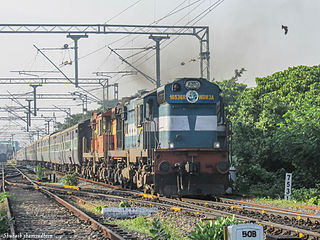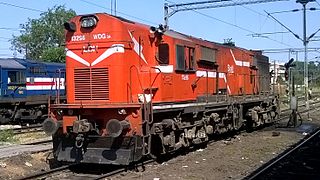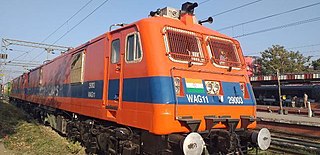
The American Locomotive Company was an American manufacturer that operated from 1901 to 1969, initially specializing in the production of locomotives but later diversifying and fabricating at various times diesel generators, automobiles, steel, tanks, munitions, oil-production equipment, as well as heat exchangers for nuclear power plants.
The Indian locomotive class WDM-2 is a class of diesel-electric locomotive that was developed in 1962 by American Locomotive Company (ALCO) for Indian Railways. The model name stands for broad gauge (W), Diesel (D), Mixed traffic (M) engine, 2nd generation (2). They entered service in 1962. A total of more than 2,700 WDM-2 was built at ALCO and Banaras Locomotive Works, Varanasi between 1962 and 1998, which made them the most numerous class of mainline diesel locomotive until its successor the WDM-3A.

The Indian locomotive class WDP-4 is a passenger-hauling diesel-electric locomotive with AC electric transmission designed by General Motors Electro-Motive Division and built by both GM-EMD and under license by Banaras Locomotive Works (BLW) of Varanasi, India for Indian Railways as the classes WDP4, WDP4B and WDP4D. The GT46PAC is a passenger version of the previous Indian Railways EMD GT46MAC freight locomotive. The locomotive has a 16-cylinder 710G3B diesel engine and is one of the fastest diesel-electric locomotives in service in Indian Railways.

The Indian locomotive class WDM-4 is a class of diesel-electric locomotive that was developed in 1962 by Electro-Motive Diesel for Indian Railways. The model name stands for broad gauge (W), Diesel (D), Mixed traffic (M) engine, 4th generation (4). They entered service in 1962. A total of 72 WDM-4 locomotives were built between 1961 and 1962.

The Indian locomotive class WDM-3A is a class of diesel–electric locomotive that was developed in 1993 by Banaras Locomotive Works (BLW), Varanasi for Indian Railways. The model name stands for broad gauge (W), Diesel (D), Mixed traffic (M) engine, with 3300 horsepower (3A). The WDM-3A is a later classification of earlier WDM-2C. They entered service in 1994. A total of 143+ were built at ALCO and Banaras Locomotive Works between 1994 and 2003 with rest of the 1246 units being rebuilt from WDM-2 which made them the most numerous class of mainline diesel locomotive until the WDG-4.

The class YDM-4 is Indian Railways' workhorse diesel locomotive. The first units were imported fully built from the American Locomotive Company (Alco) in 1961. Since 1968, it has been manufactured in India by the Banaras Locomotive Works (BLW), Varanasi. The model name stands for metre gauge (Y), diesel (D), mixed traffic (M) engine. The YDM-4 has been the most successful diesel locomotive in the metre gauge operation of Indian Railways. The YDM-4A is a variant of the YDM-4 supplied by MLW. Originally equipped with vacuum brakes. Some were later equipped with dual brakes, particularly those working in the Northeast Frontier Railway were retrofitted with dual brake system by Lumding shed. The YDM-4 locos have a maximum speed of 100 km/h (62 mph), restricted to 85 km/h (53 mph).

Diesel Loco Shed, Gooty is an engine shed located in Gooty, Andhra Pradesh in India. It falls under the jurisdiction of Guntakal railway division of South Central Railway zone.

Diesel Loco Shed, Sabarmati is an locomotive maintenance shed located in Sabarmati, Ahmedabad, Gujarat in India. It is located east of Sabarmati falling under Ahmedabad railway division. The shed caters to the needs of freight as well as passenger trains.

The Indian locomotive class WDM-3D is a class of diesel-electric locomotive that was developed in 2003 by Banaras Locomotive Works (BLW), Varanasi for Indian Railways. The model name stands for broad gauge (W), Diesel (D), Mixed traffic (M) engine with 3300 horsepower (3D). The engine is classified WDM-3D though it outputs only 3300 hp and not 3400 hp as the name should suggest. They entered service in 2003. A total of 590+ WDM-3D were built at Banaras Locomotive Works (BLW), Varanasi between 2003 and 2016.

The Indian locomotive class WDP-3A, colloquially nicknamed the Toaster, is a class of diesel-electric locomotive that was developed in 1998 by Banaras Locomotive Works, Varanasi for Indian Railways. The model name stands for broad gauge (W), Diesel (D), Passengers traffic (P) locomotive with 3100 horsepower (3A). The WDP-3A is a later classification of earlier WDP-2. They entered service in 1998. A total of 44 were built between 1998 and 2001.

The Indian locomotive class WDG-3A is a class of diesel-electric locomotive that was developed in 1994 by Banaras Locomotive Works (BLW),Varanasi for Indian Railways. The model name stands for broad-gauge (W), Diesel (D), Goods traffic (G) engine, 3,100 hp (3A) locomotive. They entered service on 18 July 1995. A total of 1,164 WDG-3A units were built between 1994 and 2015 at BLW, Varanasi with a few units being produced by Diesel Loco Modernisation Works (DLMW) and Parel Workshop.

The Indian locomotive class WDS-6 is a diesel-electric locomotive used by the Indian Railways mainly for shunting and also for performing departmental duties. The model name stands for broad gauge (W), Diesel (D), Shunting (S) engine, 6th generation (6). As of April 2022, 375 units of this class are currently in use all over India.

The Indian locomotive class WAG-11 is a class of twin-section 25 kV AC electric locomotives that was developed in 2018 by Banaras Locomotive Works (BLW), Varanasi for Indian Railways. This freight engine has been designed for 105-km/hourspeed and weighs 252 tons. It is equipped with three-phase induction motor,four power converters and regenerative as well as pneumatic braking system. The model name stands for broad gauge (W), Alternating Current (A), Goods traffic (G), and 11th in series (11). They entered trials service in 2019. A total of 4 WAG-11 pairs have been built by Banaras Locomotive Works (BLW), Varanasi.

The Indian locomotive class YDM-1 is a class of diesel-Hydraulic locomotive that was developed in 1954 by North British Locomotive Company (NBL) for Indian Railways. The model name stands for Metre gauge (Y), Diesel (D), Mixed traffic (M) engine, 1st generation (1). They entered service in 1955. A total of 20 YDM-1 locomotives was built between 1954 and 1956, which made them among the first MG main-line diesels.
The Indian locomotive class YDM-2 is a class of diesel-Hydraulic locomotive that was developed in 1986-90 by Chittaranjan Locomotive Works for Indian Railways. The model name stands for Metre gauge (Y), Diesel (D), Mixed traffic (M) engine, 2nd generation (2). They entered service in 1986. A total of 41 YDM-2 locomotives was built between 1986 and 1990.
The Indian locomotive class YDM-3 is a class of diesel-electric locomotive that was developed in 1964 by GM-EMD for Indian Railways. The model name stands for Metre gauge (Y), Diesel (D), Mixed traffic (M) engine, 3rd generation (3). They entered service in 1962. A total of 30 YDM-3 locomotives was built between 1961 and 1962.
The WDM-2G is a class of diesel electric genset locomotive used in Indian Railways. It is one of the rarest locomotives in India with only two units being produced by Patiala Locomotive Works (PLW). The locomotives were produced with an intention of being fuel efficient and to be used for light to medium duties such as short passenger runs along with occasional shunting. They are one of the only two classes of locomotives in India to feature multiple prime movers, the other example being WDS-6G, which was designed solely for shunting. They have a rated power of 2,400 HP.

The class WDS-5 is a diesel-electric locomotive used by Indian Railways for shunting and doing departmental works. The model name stands for broad gauge (W), Diesel (D), Shunting (S) engine. The WDS-6 is used all over India.
The Indian locomotive class WDS-8 is a class of diesel-electric locomotive that was developed in 1979 by the Chittaranjan Locomotive Works for Indian Railways, but ended up being delivered exclusively to the private sector. The model name stands for broad gauge (W), Diesel (D), Shunter (S) engine, 8th generation (8). They entered service in 1979. A total of five WDS-8 locomotives was built at Chittaranjan Locomotive Works (CLW), Chittaranjan between 1979 and 1982.
The Indian locomotive class WAP-3 was a class of 25 kV AC electric locomotives that was designed by Research Design and Standards Organization (RDSO) and Chittaranjan Locomotive Works (CLW) for Indian Railways in 1987. The model name stands for Broad gauge (W), AC Current (A), Passenger traffic (P) locomotive, 3rd generation (3). They entered service in 1988. They were the faster variant of the previous WAP-1 class. A total of 9 WAP-3 were converted from existing WAP-1 units at CLW between 1987 and 1988. All locomotives were now withdrawn from service and converted back to WAP-1.

















